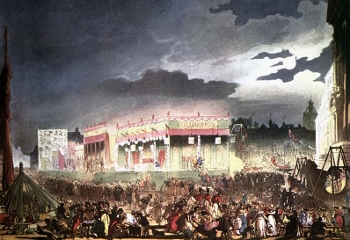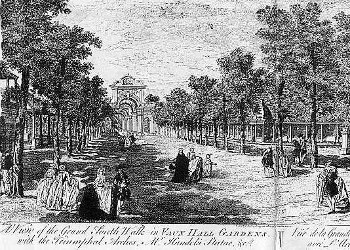My family and I recently returned from what for us is a rare activity–a vacation! We had a thoroughly lovely time at the two Universal Studios theme parks in Orlando, Florida (and came home just in time for the blizzard that affected much of the northeast U.S.). My husband’s random comment that much of what we did and saw “could barely have been imagined even fifty years ago” started me thinking about which aspects of our vacation might or might not have been at least recognizable to a Regency time traveler.
The notion of a theme or amusement park itself would certainly not be foreign to our visitor, for the fairs and pleasure gardens familiar to him or her were exactly the roots of the “Magic Kingdoms” and “Islands of Adventure” we have today. The history of fairs as gathering places for both trade and amusement goes back to ancient times well before the Middle Ages, and both the Bartholomew Fair, a chartered London fair held in the fall from 1133 to 1855, and the Sturbridge Fair, held in Cambridge (1211-1882 or longer), are historically famous in England. If you look carefully at the 1808 illustration of the Bartholomew Fair, you can see all the familiar elements – throngs of people, and vendors selling wares, spectacle/show stages and also rides –note the giant swings at the right, and the “spin-around” on the left (we had one of those in my schoolyard when I was a kid). There is even a “pleasure wheel” (an early form of ferris wheel) in the background. Granted, a large number of the rides at Universal are roller coasters of various sorts, but a little research reveals that roller coasters originated in Russia during the 1600s in the form of ice slides –70-foot ice-covered ramps with wooden frames for riders to slide down. By 1784, wheeled vehicles were being used (powered by gravity, I suspect), and by 1812 in Paris they had even learned to lock the cars onto the tracks! I did not find evidence that these had reached England by then, however. More investigation needed!
The idea of a fair running all year long on a permanent basis might surprise our Regency friend at first, but not after the example of the pleasure garden is considered. Pleasure gardens date as far back as the mid-16th century, providing a permanent acreage set aside for entertainment and recreation. Pavillions and long walkways were standard landscape features, all illuminated by hundred of oil lamps. Vauxhall Gardens in London (originally opened in 1661) is the one most associated with our period as Ranelagh Gardens closed in 1803, but there were similar gardens in many places. Games, dancing, concerts and fireworks, tightrope walkers, hot air balloon ascents, re-enactments of sieges and battles, illusions of exotic places…gee, with the exception of the hot air balloons, I think I saw all of these at Universal. Do you see a similarity in the two pictures below?
Modern technology has given a new spin to all of these time-tested crowd-pleasers –computers now control everything and video enhances many of the rides. The big thrill in Hogwarts in the Harry Potter section of Islands of Adventure is basically riding a moving gyroscope, a very new way to use technology that was only in its infancy during the Regency. The fireworks display and waterworks we saw in the evening at closing time at Universal included a fabulous light show and projection of images on the constantly changing configurations of fountains and curtains of water well beyond anything Vauxhall would have been able to produce. But you know, the descriptions of period illusions and shows they did manage to put on are quite impressive, even by today’s standards.
My husband pointed out that the biggest difference that might have truly frightened our visitor is the speed of everything. Coming from a world where people were frightened by the speed of trains when they were introduced at 35mph, and where at one time 20 miles was considered a full day’s travel, to our world where 20mph is considered an annoying snail’s pace, our Regency time-traveler might think twice about going on a rollercoaster traveling at 90 miles an hour. I know I passed on some of those myself! I think in the end that he or she would have been more astounded by this and by the building technology in the parks, the moving sidewalks, the acres of parking lots and rows of huge parking garages, the cell phones and cameras (and the skimpy clothing on the tourists) than by the parks or entertainments themselves. But since our visitor is obviously intrepid (having time-traveled, after all), after equipping him or herself with an appropriate t-shirt, I am certain he/she would have enjoyed the time spent there every bit as much as we did.
For more information about VauxhallGardens, I recommend these websites (among many):
www.vauxhallandkennington.org.uk
www.history.co.uk/explore-history/history-of-london/pleasure-gardens.html
Gail Eastwood
www.gaileastwoodauthor.com



